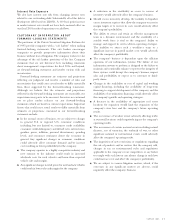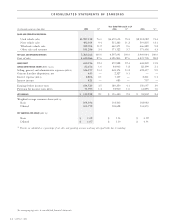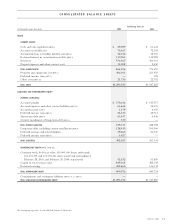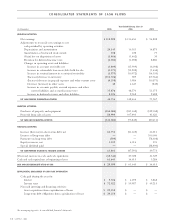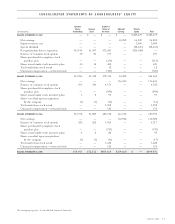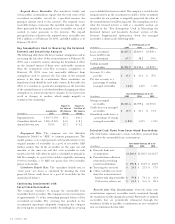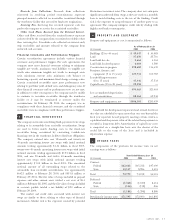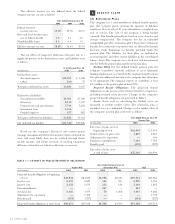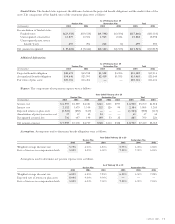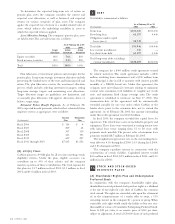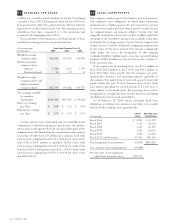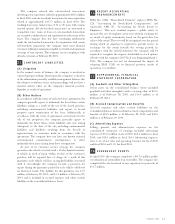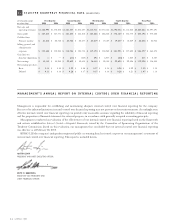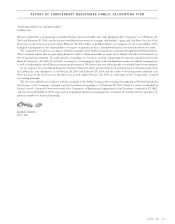CarMax 2005 Annual Report Download - page 37
Download and view the complete annual report
Please find page 37 of the 2005 CarMax annual report below. You can navigate through the pages in the report by either clicking on the pages listed below, or by using the keyword search tool below to find specific information within the annual report.
CARMAX 2005
35
SECURITIZATIONS
The company uses a securitization program to fund
substantially all of the automobile loan receivables originated by
CAF. The company sells the automobile loan receivables to a
wholly owned, bankruptcy-remote, special purpose entity that
transfers an undivided interest in the receivables to a group of
third-party investors. The special purpose entity and investors
have no recourse to the company’s assets. The company’s risk is
limited to the retained interest on the company’s consolidated
balance sheets. The investors issue commercial paper supported
by the transferred receivables, and the proceeds from the sale of
the commercial paper are used to pay for the securitized
receivables. This program is referred to as the warehouse facility.
The company periodically uses public securitizations to
refinance the receivables previously securitized through the
warehouse facility. In a public securitization, a pool of
automobile loan receivables is sold to a bankruptcy-remote,
special purpose entity that in turn transfers the receivables to a
special purpose securitization trust. The securitization trust
issues asset-backed securities, secured or otherwise supported by
the transferred receivables, and the proceeds from the sale of the
securities are used to pay for the securitized receivables. The
earnings impact of refinancing receivables in a public
securitization has not been material to the operations of the
company. However, because securitization structures could
change from time to time, this may not be representative of the
potential impact of future securitizations.
The transfers of receivables are accounted for as sales in
accordance with SFAS No. 140. When the receivables are
securitized, the company recognizes a gain or loss on the sale of
the receivables as described in Note 3.
Years Ended February 28 or 29
(In millions) 2005 2004 2003
Net loans originated $1,490.3 $1,407.6 $1,189.0
Loans sold $1,534.8 $1,390.2 $1,185.9
Gains on sales of loans $ 58.3 $ 65.1 $ 68.2
Gains on sales of loans as a
percentage of loans sold 3.8% 4.7% 5.8%
Retained Interest
The company retains an interest in the automobile loan
receivables that it securitizes. The retained interest, presented as a
current asset on the company’s consolidated balance sheets,
serves as a credit enhancement for the benefit of the investors in
the securitized receivables. The retained interest includes the
present value of the expected residual cash flows generated by
the securitized receivables, or “interest-only strip receivables,”
the restricted cash on deposit in various reserve accounts, and an
undivided ownership interest in the receivables securitized
through the warehouse facility and certain public securitizations,
or “required excess receivables,” as described below. On a
combined basis, the cash reserves and required excess receivables
are generally 2% to 4% of managed receivables. The special
purpose entities and the investors have no recourse to the
company’s assets. The company’s risk is limited to the retained
interest on the company’s consolidated balance sheets. The fair
value of the retained interest may fluctuate depending on the
performance of the securitized receivables.
The fair value of the retained interest was $148.0 million as
of February 28, 2005, and $146.0 million as of February 29,
2004. The retained interest had a weighted average life of 1.5
years as of February 28, 2005, and as of February 29, 2004. As
defined in SFAS No. 140, the weighted average life in periods
(for example, months or years) of prepayable assets is calculated
by multiplying the principal collections expected in each future
period by the number of periods until that future period,
summing those products, and dividing the sum by the initial
principal balance.The following is a detailed explanation of the
components of the retained interest.
Interest-Only Strip Receivables. Interest-only strip receivables
represent the present value of residual cash flows the company
expects to receive over the life of the securitized receivables. The
value of these receivables is determined by estimating the future
cash flows using management’s assumptions of key factors, such as
finance charge income, default rates, prepayment rates, and
discount rates appropriate for the type of asset and risk. The value
of interest-only strip receivables may be affected by external
factors, such as changes in the behavior patterns of customers,
changes in the strength of the economy, and developments in the
interest rate markets; therefore, actual performance may differ
from these assumptions. Management evaluates the performance
of the receivables relative to these assumptions on a regular basis.
Any financial impact resulting from a change in performance is
recognized in earnings in the period in which it occurs.
Restricted Cash. Restricted cash represents amounts on
deposit in various reserve accounts established for the benefit of
the securitization investors. In the event that the cash generated
by the securitized receivables in a given period was insufficient
to pay the interest, principal, and other required payments, the
balances on deposit in the reserve accounts would be used to pay
those amounts. In general, each of the company’s securitizations
requires that an amount equal to a specified percentage of the
initial receivables balance be deposited in a reserve account on
the closing date and that any excess cash generated by the
receivables be used to fund the reserve account to the extent
necessary to maintain the required amount. If the amount on
deposit in the reserve account exceeds the required amount, an
amount equal to that excess is released through the special
purpose entity to the company. In the public securitizations, the
amount required to be on deposit in the reserve account must
equal or exceed a specified floor amount. The reserve account
remains at the floor amount until the investors are paid in full, at
which time the remaining reserve account balance is released
through the special purpose entity to the company. The amount
required to be maintained in the public securitization reserve
accounts may increase depending upon the performance of the
securitized receivables. The amount on deposit in restricted cash
accounts was $33.5 million as of February 28, 2005, and $34.8
million as of February 29, 2004.
4




